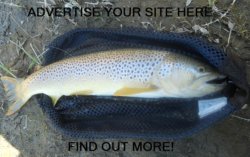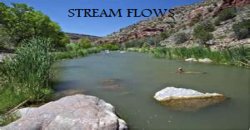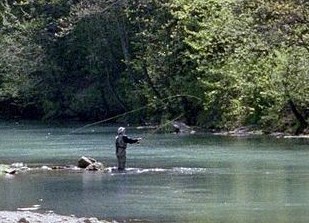|
CASTING
Fly casting is a lot easier than it looks. For a beginner fly casting can be difficult to learn by reading how to do it, and for some it will be difficult to learn by watching a video. So don’t get frustrated. Try one method and if you are having trouble with it, try the other. If you are still having trouble ask an experienced fly-fisherman for help.
OVERHEAD CAST This is the cast you see most often in movies, but it is not the method used most often by most fishermen. You will use this method when casting on slower moving water and when drying a fly with what is called a “false cast”. Grip the rod by holding it like you are shaking hands with someone. Your thumb should be on top and your fingers below the rod and your hand should be in the middle of the grip area. You will keep the fly line between your index finger and fly rod for control.
Time for the back cast; walk backwards until you reach a point where all the stripped line is in a somewhat straight line in front of you. Keeping your wrist stationary, lift the tip of the rod up by raising your forearm until line is tight. Quickly rotate your arm backward to bring the line behind you. Stop the rod near the top of your back cast, at about 2:00, which will release the line and it should form a loop and gracefully unfold behind you. Pause for a moment, watch the line behind you and when it is fully extended you will begin your forward cast. The forward cast starts when the line is completely unfolded behind you. Bring your arm forward to the 10:00 position and stop the rod. The line will follow, as it passes over you gently lower the tip of the rod and the line will drop softly in front of you with the line tight.
This cast will take a lot of repetition to get good at, but soon you will realize that it is not difficult. It is sometimes hard to read how to do it, or watch it done, but once you understand it you will begin to get really good at it. You can practice casting in your yard or a nearby park, just tie a piece of colored yard at the end of the fly line so you can see how you are doing. False casting is used to either dry a fly when it has become to wet, or to shoot more line out for a longer cast. You basically do everything the same but you don’t let the line hit the water in front of you. Instead of allowing the line to fall, you start the back cast after the line is fully extended in front of you. Loosen the grip near the completion of the forward cast to extend more line. You should be able to fill it slipping through your fingers. Remember to always cast straight back and forth above you. Do not overhead cast side armed or at ¾ perpendicular. The best casts will be straight overhead. The goal is to keep the line tight at all times.
You will use this type of cast when fishing areas where a back cast is not possible because of bushes and trees. This is also an effective cast if there is a lot of wind, or if you just want to reset your fly quickly. To visualize the roll cast imagine that you are on a pond and there is no current just flat water. With your line out away from you and tight, raise your arm above your head and the tip up to the 1:00 position keeping the line tight. Now quickly lower the rod in the direction of the cast. You will notice a loop form and then unfold in the direction of the cast. The trick to this cast is the quick forward motion. You will not be able to practice this cast unless you are on the water since it is the tension of the water that helps load the cast. This cast will work on slow flat water or faster streams. FLIP CAST When fishing a stream with current you don’t always need to use an overhead cast to position your fly upstream. When the fly gets all the way out downstream and starts to drift towards the shoreline it is time to use a flip cast. Simply throw your tip towards where you want the fly to land. This works best for nymphs since a dry fly will become wet and a series of “false casts” will help dry the fly occasionally. Once you have done the flip cast you just need to keep an eye on the fly line and not let it pull the fly. You may need to mend the line to make the proper presentation.
|
Support our Website
View one of these related sites.

Sign up for Fish On News Letter
Receive regular newsletters about fly-fishing. Featuring great specials from our affiliate sponsors, new fish photos, tactics, product reviews and other fly-fishing articles. Fill out the form below to subscribe. Fish On!
Most Searched States
Montana
Colorado
Alaska
Oregon
Washington
North Carolina
California
Florida
Idaho
Utah
Stock Assault
Revolutionary Stock Trading Software proven to generate profitable winning trades on Autopilot in only one hour a day. State-of-the-art Artificial Intelligence. Click Here!
ROULETTE SYSTEM
Very best manual showing how to profit from online or real Casino’s Click Here!
Attract & Seduce Women
Learn how to meet, attract and seduce women -- from a woman. Best selling attraction and seduction guide for over 8 years. Click Here!
Trading Pro System
Make money regardless of whether the market goes up or down. Better that forex, penny stocks, day trading and swing trading. Over 24 hours of video. Click Here!
Click below for stream flow data
This is nationwide data, select your state, click real time data, then choose location. Having stable water conditions makes for better fishing.






 So to recap, when you stand facing forward and hold your arm straight above your head that will be 12:00. From the start position with your tip in front of you, you will back cast quickly by raising your forearm until it points to 2:00. Pause and let the loop unfold behind you. When it unfolds quickly move your forearm back to 10:00 and as the line passes over your head begin to slowly lower the tip.
So to recap, when you stand facing forward and hold your arm straight above your head that will be 12:00. From the start position with your tip in front of you, you will back cast quickly by raising your forearm until it points to 2:00. Pause and let the loop unfold behind you. When it unfolds quickly move your forearm back to 10:00 and as the line passes over your head begin to slowly lower the tip.
